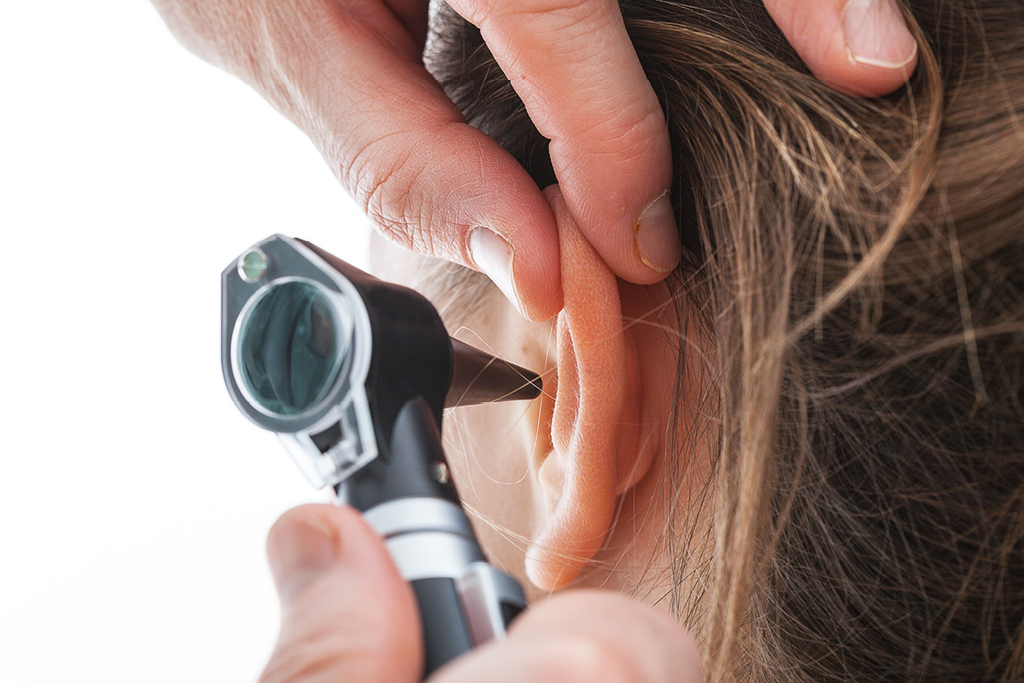
Hearing loss can come on slowly, and it can cause a disconnect for those experiencing it.
Hearing problems cover a range of severity, from loss of sensitivity to certain sounds to total hearing loss. Some hearing loss can be corrected.
The specialists at Wilmington Health recommend a comprehensive hearing test for anyone experiencing these symptoms:
- Feeling people mumble all the time
- Family, friends, and co-workers often have to repeat themselves when speaking to you
- Finding it difficult to make out the words of songs or dialogue in movies
- More difficulty in noisy environments
- Requiring a higher volume on the TV than others
- Trouble following conversations
- Ringing, buzzing, or hissing sounds in your ears
Adults should have a hearing test every 10 years until age 50, and then every three years, even if they don’t suspect hearing loss.
“Usually people start having communication problems with their family members,” said Wilmington Health’s Aimee Parker, MS, FAAA, AuD. “Often, they talk about having more difficulty in noisy places. Anytime someone has a communication problem, it’s smart to check it out.”
The National Institute on Deafness and Other Communication Disorders says 28 million Americans have hearing problems. It affects people as they age most, but 17 in 1,000 children younger than 18 will also have hearing loss.
What happens with hearing loss?
Sound enters the ear and its three major parts: the outer ear, middle ear, and inner ear. It moves through the ear canal to the eardrum, which vibrates and transmits signals to the bones of the middle ear.
The ossicles amplify sound and transmit it to the inner ear to the cochlea, a fluid-filled organ. Vibrations cause ripples in the fluids which bend projections from tiny hair cells, sending electrical impulses to the auditory nerve. The brain translates signals.
Problems in any part of this process can disrupt clear hearing. That’s when an exam is warranted.
“It doesn’t always mean they need to get hearing aids, but it’s an excellent place to start, with a comprehensive hearing test,” Dr. Aimee Parker said. “We work with ear, nose, and throat doctors when people have ear or balance problems, and we dispense hearing aids for adults. Working with the three ear, nose, and throat doctors, Dr. John Boyle, Dr. Michael Parker, and Dr. Greg Zwack, allows us to make sure the patient is taken care of medically and acoustically.”
Even mild hearing loss can have an impact.
Causes of hearing loss
Here are the most common.
BIRTH DEFECTS: The March of Dimes says this is a common reason. About half of cases are attributed to genetics, and 30% of kids with hearing problems also have other birth defects. During pregnancy, infections can cause hearing loss, including:
- Cytomegalovirus
- Herpes
- Rubella
- Toxoplasmosis
- Syphilis
Preterm babies are also at a higher risk.
DISEASES: Meniere’s disease and acoustic neuroma can cause hearing problems. The same can be said about cancer or a stroke. Measles, meningitis, and mumps, all infectious diseases, can impact hearing too.
PREBYCUSIS: Age-related hearing problems are common — 30-35% of adults 65-75 years old are affected. After age 75, it’s 50%, and it affects high-pitched sounds, such as ringtones, most. It can be difficult to focus on a specific voice in a crowded room. Common causes of prebycusis include:
- Certain medications
- Diabetes
- Heart disease
- Heredity
- Hypertension
- Repeated exposure to loud noise
- Vascular issues
Changes happen gradually and aren’t easily detected.
OTOSCLEROSIS: The abnormal development of middle ear bones can lead to hearing problems, and it might be hereditary. It can manifest as loss of ability to detect low-pitched sounds or whispers. It can also cause balance problems and tinnitus, a ringing in the ears. Hearing aids and surgery can remedy this.
OTHER CONDITIONS AND FACTORS: These can contribute to hearing loss:
- Trauma (head injury)
- Medications (certain antibiotics and aspirin in high doses
- Mowing the lawn or using power tools
- Noise (exposure to it)
- Otitis externa (swimmer’s ear)
- Otitus media (fluid or infection in the middle ear)
- Ruptured eardrum (can cause pain too)
- Shooting guns or other weapons
- Ear wax (can also cause earache)
Older adults might retreat socially because they can’t hear as well, and isolation makes people more likely to suffer from depression.
“Hearing is something that helps people to connect with other people, with their family members, and also helps them stay involved with their community and work,” said Dr. Parker. “That’s something that is critical. We feel we can get people back so they do the things that they want to do with the people that they love.”
Hearing tests can help with other health issues, too. Untreated hearing problems can lead to:
- Anxiety
- Cognitive decline
- Depression
- Increased injury risk
You can improve your quality of life with hearing loss treatment. It’s helpful to avoid social isolation and concerns about communicating.
About hearing tests
Usually it involves wearing earphones to listen to short tones and speech at different pitches in volumes, one ear at a time. It isn’t a pass-fail exam, but rather a way to show how much hearing is affected in each ear.
Decibels are used to measure noise levels. Adults with 25 decibels of hearing loss can still hear normally. The breakdown:
- Mild hearing loss: 26 to 40 decibels
- Moderate hearing loss: 41 to 55 decibels
- Moderate-to-severe hearing loss: 56 to 70 decibels
- Severe hearing loss: 71 to 90 decibels
- Profound hearing loss: 91 to 100 decibels
For reference, a whisper in your ear is 30 decibels. Normal speech: 60. Shouting begins at 80.
Your provider might suggest wearing earplugs when you attend concerts, mow the lawn, or participate in other loud activities to help prevent hearing loss.
Hearing loss in children
It’s wise to check their hearing regularly. Mild hearing loss can cause problems with:
- Language
- Social skills
- Speech
Treatment has higher success rates if issues are detected before 6 months of age. Children who do not receive a screening before leaving the hospital at birth should be checked within three weeks. Problems found at those tests usually necessitate retesting in the next three months before treatment options are considered. The testing schedule for kids:
- Ages 4, 5, 6, 8, and 10 years
- The preteen years
- The teen years
What if my child is diagnosed with a hearing problem?
Your audiologist will collaborate with doctors, education specialists, and speech-language therapists to develop a treatment plan. Support groups can help families navigate through treatments and adjustments, too.
Treatment and options for hearing loss
Some treatments are easy, such as ear flushing for ear wax buildup. Other cases might require medication or surgery, or both. Physicians treat bacterial infections with antibiotics. For otosclerosis, a surgeon might need to remove excess bone growth.
A check of your hearing can help you address balance issues stemming from imbalances in the inner ear.
Conditions without cures
Sensorineural hearing problems stem from the inner ear or auditory nerve and aren’t considered reversible. Strategies to address these include:
- AMERICAN SIGN LANGUAGE: A language that uses signs and hand movements, and includes facial expressions and body postures.
- ASSISTIVE LISTENING DEVICES: Telephone amplifiers, etc.
- CAPTIONING: Words displayed on television screens to describe audio or sound in programs.
- COCHLEAR IMPLANT: Small, intricate electronic device surgically implanted that can boost the sense of sound in those severely hard of hearing or deaf.
- SPEECH READING: Using visual cues to understand the spoken word can help those with presbycusis (age-related hearing loss).
Hearing aids
These can help with hearing loss caused by damage to the inner ear. For one or both ears, hearing aids can be worn in various places, including:
- Behind the ear
- In the ear
- In the ear canal
- On the body
Hearing aids include:
- A microphone, to pick up sound
- An amplifier, to make the sound louder
- A speaker, to bring sound to the ear
- A battery
Turn to Wilmington Health for hearing screenings
The professionals at Wilmington Health can help get you caught up on screenings and answer questions about your hearing. Ask your primary care physician about hearing loss today.
“Wilmington Health has a high focus on patient care, and that is true in our department as well,” said Wilmington Health’s David Gagliardi, AuD. “We’re focused on making them as happy as possible.”
